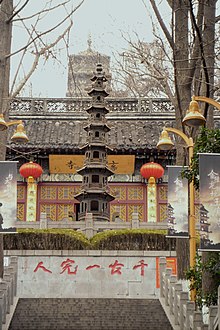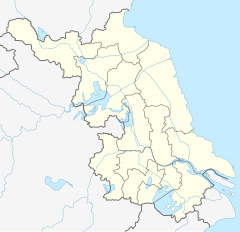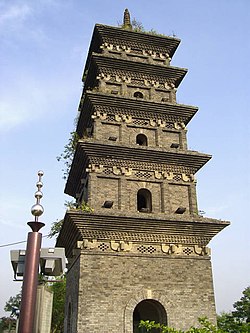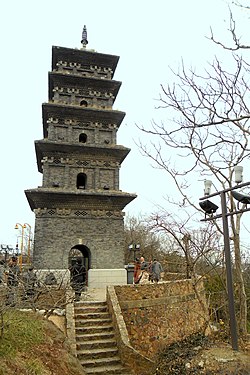Xuanzang Temple (Nanjing)
| Xuanzang Temple | |
|---|---|
玄奘寺 | |
 Front view | |
| Religion | |
| Affiliation | Buddhism |
| Sect | Chan Buddhism |
| Leadership | Shi Chuanzhen |
| Location | |
| Location | Xuanwu District, Nanjing, Jiangsu, China |
| Geographic coordinates | 32°04′03″N 118°48′45″E / 32.06750°N 118.81250°E |
| Architecture | |
| Style | Chinese architecture |
| Date established | 2003 |
| Materials | Bricks and cement |
Xuanzang Temple (Chinese: 玄奘寺; pinyin: Xuánzàng Sì) is a Buddhist temple located within Jiuhua Mountain Park, in Xuanwu District, Nanjing, Jiangsu, China.[1]
History
In the early winter of 1942, the occupying Imperial Japanese Army dug a stone envelope at the ruins of Sanzang Pagoda at Great Bao'en Temple which contained the Śarīra of the Tang dynasty (618–907) eminent monk Xuanzang. In early 1943, the Wang Jingwei government built a brick tower to worship the Śarīra of Xuanzang, which was named Sanzang Pagoda (三藏塔).
Xuanzang Temple was built by the Xuanwu District Government in 2003 in memory of eminent Buddhist monk Xuanzang of the Tang dynasty. Shi Chuanzhen, a leader of Qixia Temple, was proposed as abbot of the temple.[2]
In 2004, Xuanzang Temple was designated as a National Patriotism Education Demonstration Base by the Nanjing Municipal People's Government.[3]
In July 2022, memorial tablets of war criminals of the Imperial Japanese Army, including Tanaka Gunkichi, Iwane Matsui, Hisao Tani and Noda Tsuyoshi, were found in Xuanzang Temple, which caused the dismissal of the abbot Shi Chuanzhen and the punishment of local officials.[4][5][6]
Gallery
References
- ^ Kate, Zhang (22 July 2022). "Nanjing punishes officials for temple honouring Japanese war criminals". South China Morning Post. Retrieved 23 July 2022.
- ^ 南京玄奘寺传真法师曾和南京多名落马高官熟识. sina (in Chinese). 23 July 2022. Retrieved 23 July 2022.
- ^ Xu Qi'an (許祺安) (23 July 2022). 寺廟供奉戰犯辦日本慶典 南京市遭抨擊 官方回應:不會忘記歷史. hk01.com (in Chinese). Retrieved 23 July 2022.
- ^ Cang, Wei (22 July 2022). "Temple sparks anger over war criminals". Chinadaily.com. Retrieved 23 July 2022.
- ^ Cang, Wei (23 July 2022). "Millions angered as Japanese war criminals enshrined at temple". Chinadaily.com. Retrieved 23 July 2022.
- ^ Wang, Qingchu (22 July 2022). "Japanese war criminals' memorial tablets found in Nanjing temple". shine.cn. Retrieved 23 July 2022.




